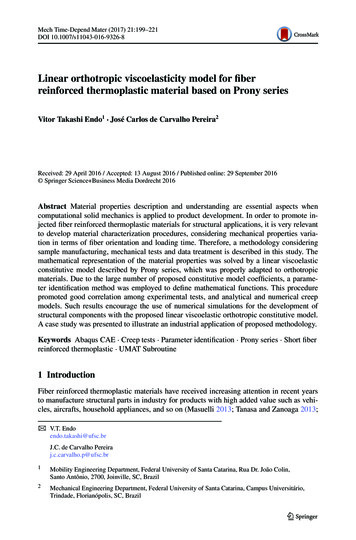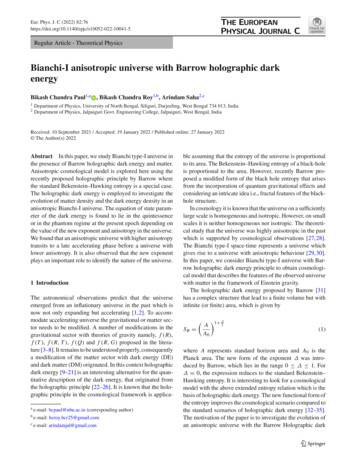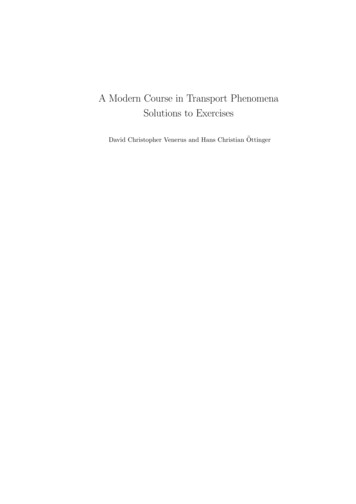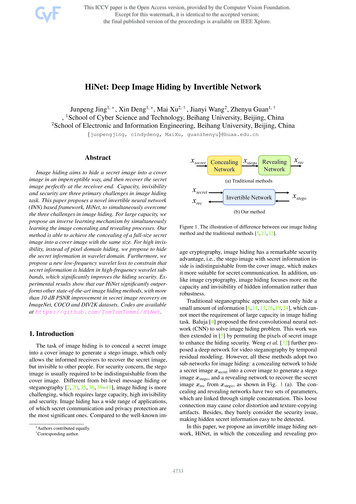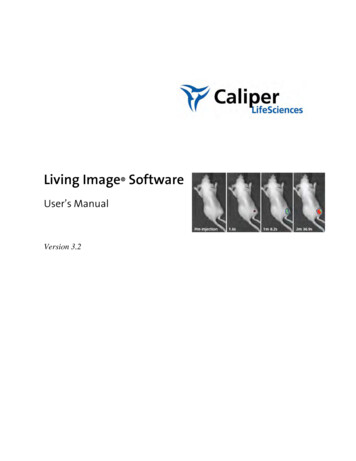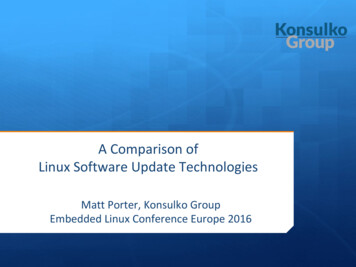
Transcription
Anisotropic Diffusionin Image ProcessingJoachim WeickertB.G. Teubner Stuttgart
Anisotropic Diffusionin Image ProcessingJoachim WeickertDepartment of Computer ScienceUniversity of CopenhagenCopenhagen, DenmarkB.G. Teubner Stuttgart 1998
Dr. rer. nat. Joachim WeickertBorn in 1965 in Ludwigshafen/Germany. Studies in mathematics, physics and computer science at the University of Kaiserslautern. 1987 B.Sc. in physics and industrial mathematics. 1991 M.Sc. in industrial mathematics. 1996 Ph.D. in mathematics. Postdoctoral researcher at the Image Sciences Institute at Utrecht University from 2/96 to 3/97. Since then visiting assistant research professor at theDepartment of Computer Science, Copenhagen University.The cover image shows a thresholded nonwoven fabric image which was processedby applying a coherence-enhancing anisotropic diffusion filter (see Section 5.2 formore details). The goal was to visualize the quality relevant adjacent fibre structures, so-called stripes. The displayed equations describe the basic structure ofnonlinear diffusion filtering in the continuous, semidiscrete, and fully discrete setting. Their theoretical foundations are treated in Chapters 2–4.c Copyright 2008 by Joachim Weickert.All rights reserved. No part of this book may be reproduced by any means, ortransmitted, or translated into a machine language without the written permissionof the author.This book had been published by B. G. Teubner (Stuttgart) in 1998 and went outof print in 2001. The copyright has been returned to the author in 2008. In thecurrent version a few typos and other errors have been corrected.
To my parents Gerda and Norbert
PrefacePartial differential equations (PDEs) have led to an entire new field in imageprocessing and computer vision. Hundreds of publications have appeared in the lastdecade, and PDE-based methods have played a central role at several conferencesand workshops.The success of these techniques is not really surprising, since PDEs have provedtheir usefulness in areas such as physics and engineering sciences for a very longtime. In image processing and computer vision, they offer several advantages: Deep mathematical results with respect to well-posedness are available, suchthat stable algorithms can be found. PDE-based methods are one of themathematically best-founded techniques in image processing. They allow a reinterpretation of several classical methods under a novel unifying framework. This includes many well-known techniques such as Gaussianconvolution, median filtering, dilation or erosion. This understanding has also led to the discovery of new methods. Theycan offer more invariances than classical techniques, or describe novel waysof shape simplification, structure preserving filtering, and enhancement ofcoherent line-like structures. The PDE formulation is genuinely continuous. Thus, their approximationsaim to be independent of the underlying grid and may reveal good rotationalinvariance.PDE-based image processing techniques are mainly used for smoothing andrestoration purposes. Many evolution equations for restoring images can be derived as gradient descent methods for minimizing a suitable energy functional, andthe restored image is given by the steady-state of this process. Typical PDE techniques for image smoothing regard the original image as initial state of a parabolic(diffusion-like) process, and extract filtered versions from its temporal evolution.The whole evolution can be regarded as a so-called scale-space, an embedding ofthe original image into a family of subsequently simpler, more global representations of it. Since this introduces a hierarchy into the image structures, one can usea scale-space representation for extracting semantically important information.One of the two goals of this book is to give an overview of the state-of-the-art ofPDE-based methods for image enhancement and smoothing. Emphasis is put on av
viPREFACEunified description of the underlying ideas, theoretical results, numerical approximations, generalizations and applications, but also historical remarks and pointersto open questions can be found. Although being concise, this part covers a broadspectrum: it includes for instance an early Japanese scale-space axiomatic, theMumford–Shah functional for image segmentation, continuous-scale morphology,active contour models and shock filters. Many references are given which point thereader to useful original literature for a task at hand.The second goal of this book is to present an in-depth treatment of an interesting class of parabolic equations which may bridge the gap between scale-space andrestoration ideas: nonlinear diffusion filters. Methods of this type have been proposed for the first time by Perona and Malik in 1987 [326]. In order to smooth animage and to simultaneously enhance important features such as edges, they applya diffusion process whose diffusivity is steered by derivatives of the evolving image.These filters are difficult to analyse mathematically, as they may act locally likea backward diffusion process. This gives rise to well-posedness questions. On theother hand, nonlinear diffusion filters are frequently applied with very impressiveresults; so there appears the need for a theoretical foundation.We shall develop results in this direction by investigating a general class ofnonlinear diffusion processes. This class comprises linear diffusion filters as well asspatial regularizations of the Perona–Malik process, but it also allows processeswhich replace the scalar diffusivity by a diffusion tensor. Thus, the diffusive fluxdoes not have to be parallel to the grey value gradient: the filters may becomeanisotropic. Anisotropic diffusion filters can outperform isotropic ones with respectto certain applications such as denoising of highly degraded edges or enhancingcoherent flow-like images by closing interrupted one-dimensional structures. In order to establish well-posedness and scale-space properties for this class, we shallinvestigate existence, uniqueness, stability, maximum–minimum principles, Lyapunov functionals, and invariances. The proofs present mathematical results fromthe nonlinear analysis of partial differential equations.Since digital images are always sampled on a pixel grid, it is necessary to knowif the results for the continuous framework carry over to the practically relevantdiscrete setting. These questions are an important topic of the present book aswell. A general characterization of semidiscrete and fully discrete filters, whichreveal similar properties as their continuous diffusion counterparts, is presented. Itleads to a semidiscrete and fully discrete scale-space theory for nonlinear diffusionprocesses. Mathematically, this comes down to the study of nonlinear systems ofordinary differential equations and the theory of nonnegative matrices.Organization of the book. Image processing and computer vision are interdisciplinary areas, where researchers, practitioners and students may have a verydifferent scientific background and differing intentions. As a consequence, I havetried to keep this book as self-contained as possible, and to include various aspects
PREFACEviisuch that it should contain interesting material for many readers. The prerequisitesare kept to a minimum and can be found in standard textbooks on image processing [163], matrix analysis [407], functional analysis [9, 58, 7], ordinary differentialequations [56, 412], partial differential equations [185] and their numerical aspects[293, 286]. The book is organized as follows:Chapter 1 surveys the fundamental ideas behind PDE-based smoothing andrestoration methods. This general overview sketches their theoretical properties,numerical methods, applications and generalizations. The discussed methods include linear and nonlinear diffusion filtering, coupled diffusion–reaction methods,PDE analogues of classical morphological processes, Euclidean and affine invariantcurve evolutions, and total variation methods.The subsequent three chapters explore a theoretical framework for anisotropicdiffusion filtering. Chapter 2 presents a general model for the continuous settingwhere the diffusion tensor depends on the structure tensor (interest operator,second-moment matrix), a generalization of the Gaussian-smoothed gradient allowing a more sophisticated description of local image structure. Existence anduniqueness are discussed, and stability and an extremum principle are proved.Scale-space properties are investigated with respect to invariances and informationreducing qualities resulting from associated Lyapunov functionals.Chapter 3 establishes conditions under which comparable well-posedness andscale-space results can be proved for the semidiscrete framework. This case takesinto account the spatial discretization which is characteristic for digital images,but it keeps the scale-space idea of using a continuous scale parameter. It leadsto nonlinear systems of ordinary differential equations. We shall investigate underwhich conditions it is possible to get consistent approximations of the continuousanisotropic filter class which satisfy the abovementioned requirements.In practice, scale-spaces can only be calculated for a finite number of scales,though. This corresponds to the fully discrete case which is treated in Chapter4. The investigated discrete filter class comes down to solving linear systems ofequations which may arise from semi-implicit time discretizations of the semidiscrete filters. We shall see that many numerical schemes share typical featureswith their semidiscrete counterparts, for instance well-posedness results, extremumprinciples, Lyapunov functionals, and convergence to a constant steady-state. Thischapter also shows how one can design efficient numerical methods which are inaccordance with the fully discrete scale-space framework and which are based onan additive operator splitting (AOS).Chapter 5 is devoted to practical topics such as filter design, examples and applications of anisotropic diffusion filtering. Specific models are proposed which aretailored towards smoothing with edge enhancement and multiscale enhancementof coherent structures. Their qualities are illustrated using images arising fromcomputer aided quality control and medical applications, but also fingerprint im-
viiiPREFACEages and impressionistic paintings shall be processed. The results are juxtaposedto related methods from Chapter 1.Finally, Chapter 6 concludes the book by giving a summary and discussingpossible future perspectives for nonlinear diffusion filtering.Acknowledgments. In writing this book I have been helped and influencedby many people, and it is a pleasure to take this opportunity to express my gratitude to them. The present book is an extended and revised version of my Ph.D.thesis [416], which was written at the Department of Mathematics at the University of Kaiserslautern, Germany. Helmut Neunzert, head of the Laboratory ofTechnomathematics, drew my interest to diffusion processes in image processing,and he provided the possibility to carry out this work at his laboratory. I alsothank him and the other editors of the ECMI Series as well as Teubner Verlag fortheir interest in publishing this work.Pierre–Louis Lions (CEREMADE, University Paris IX) invited me to the CEREMADE, one of the birthplaces of many important ideas in this field. He also gaveme the honour to present my results as an invited speaker at the EMS Conference Multiscale Analysis in Image Processing (Lunteren, The Netherlands, October1994) to an international audience, and he acted as a referee for the Ph.D. thesis.After the defence of my thesis in Kaiserslautern, I joined the TGV (“toolsfor geometry in vision”) group at Utrecht University Hospital for 14 months. Inthis young and dynamic group I had the possibility to learn a lot about medicalimage analysis, and to experience Bart ter Haar Romeny’s enthusiasm for scalespace. During that time I also met Atsushi Imiya (Chiba University, Japan) ata workshop in Dagstuhl (Germany). He introduced me into the fascinating worldof early Japanese scale-space research conducted by Taizo Iijima decades beforescale-space became popular in America and Europe.In the meantime I am with the computer vision group of Peter Johansen andJens Arnspang (DIKU, Copenhagen University). The discussions and collaborations with the members of this group increased my interest in scale-space relateddeep structure analysis and information theory. In the latter field I share manycommon interests with Jon Sporring.The proofreading of this book was done by Martin Reißel and Andrea Bechtold(Kaiserslautern). Martin Reißel undertook the hard job of checking the wholemanuscript for its mathematical correctness, and Andrea Bechtold was a great helpin all kinds of difficulties with the English language. Also Robert Maas (UtrechtUniversity Hospital) contributed several useful hints.This work has been funded by Stiftung Volkswagenwerk, Stiftung Rheinland–Pfalz für Innovation, the Real World Computing Partnership, the Danish ResearchCouncil, and the EU–TMR Research Network VIRGO.Copenhagen, October 1997Joachim Weickert
Contents1 Image smoothing and restoration by PDEs1.1 Physical background of diffusion processes .1.2 Linear diffusion filtering . . . . . . . . . . .1.2.1 Relations to Gaussian smoothing . .1.2.2 Scale-space properties . . . . . . . .1.2.3 Numerical aspects . . . . . . . . . . .1.2.4 Applications . . . . . . . . . . . . . .1.2.5 Limitations . . . . . . . . . . . . . .1.2.6 Generalizations . . . . . . . . . . . .1.3 Nonlinear diffusion filtering . . . . . . . . .1.3.1 The Perona–Malik model . . . . . . .1.3.2 Regularized nonlinear models . . . .1.3.3 Anisotropic nonlinear models . . . .1.3.4 Generalizations . . . . . . . . . . . .1.3.5 Numerical aspects . . . . . . . . . . .1.3.6 Applications . . . . . . . . . . . . . .1.4 Methods of diffusion–reaction type . . . . .1.4.1 Single diffusion–reaction equations .1.4.2 Coupled systems of diffusion–reaction1.5 Classic morphological processes . . . . . . .1.5.1 Binary and grey-scale morphology . .1.5.2 Basic operations . . . . . . . . . . .1.5.3 Continuous-scale morphology . . . .1.5.4 Theoretical results . . . . . . . . . .1.5.5 Scale-space properties . . . . . . . .1.5.6 Generalizations . . . . . . . . . . . .1.5.7 Numerical aspects . . . . . . . . . . .1.5.8 Applications . . . . . . . . . . . . . .1.6 Curvature-based morphological processes . .1.6.1 Mean-curvature filtering . . . . . . .1.6.2 Affine invariant filtering . . . . . . .1.6.3 Generalizations . . . . . . . . . . . .1.6.4 Numerical aspects . . . . . . . . . . .ix. . . . . . . . . . . . . . . . . . . . . . . . . . . . . . . . . . . . . . . . . . . . . . . . . . . . . . . . . . . . . . . . . . . . . . . . . . . . . . . . . . . . . .equations. . . . . . . . . . . . . . . . . . . . . . . . . . . . . . . . . . . . . . . . . . . . . . . . . . . . . . . . . . . . . . . . . . . . . . 373737404243
xCONTENTS1.71.81.6.5 Applications . . . . . . . . . . . . .1.6.6 Active contour models . . . . . . .Total variation methods . . . . . . . . . .1.7.1 TV-preserving methods . . . . . . .1.7.2 TV-minimizing methods . . . . . .Conclusions and further scope of the book2 Continuous diffusion filtering2.1 Basic filter structure . . . . . . . . . .2.2 The structure tensor . . . . . . . . . .2.3 Theoretical results . . . . . . . . . . .2.4 Scale-space properties . . . . . . . . . .2.4.1 Invariances . . . . . . . . . . .2.4.2 Information-reducing properties3 Semidiscrete diffusion filtering3.1 The general model . . . . . .3.2 Theoretical results . . . . . .3.3 Scale-space properties . . . . .3.4 Relation to continuous models3.4.1 Isotropic case . . . . .3.4.2 Anisotropic case . . . .454649505053.55555657626265.757576818686884 Discrete diffusion filtering4.1 The general model . . . . . . .4.2 Theoretical results . . . . . . .4.3 Scale-space properties . . . . . .4.4 Relation to semidiscrete models4.4.1 Semi-implicit schemes .4.4.2 AOS schemes . . . . . .979798991021021075 Examples and applications5.1 Edge-enhancing diffusion . . .5.1.1 Filter design . . . . . .5.1.2 Applications . . . . . .5.2 Coherence-enhancing diffusion5.2.1 Filter design . . . . . .5.2.2 Applications . . . . . .113114114114127127129.6 Conclusions and perspectives135Bibliography139Index165
Chapter 1Image smoothing and restorationby PDEsPDE-based methods appear in a large variety of image processing and computervision areas ranging from shape-from-shading and histogramme modification tooptic flow and stereo vision.This chapter reviews their main application, namely the smoothing and restoration of images. It is written in an informal style and refers to a large amount oforiginal literature, where proofs and full mathematical details can be found.The goal is to make the reader sensitive to the similarities, differences, advantages and shortcomings of these techniques, and to point out the main results andopen problems in this rapidly evolving area.For each class of methods the basic ideas are explained and their theoreticalbackground, numerical aspects, generalizations, and applications are discussed.Many of these ideas are borrowed from physical phenomena such as wave propagation or transport of heat and mass. Nevertheless, also gas dynamics, crackpropagation, grassfire flow, the study of salinity profiles in oceanography, or mechanisms of the retina and the brain are closely related to some of these approaches.Although a detailed discussion of these connections would be far beyond the scopeof this work, they are mentioned wherever they appear, in order to allow theinterested reader to pursue these ideas. Also many historical notes are added.The outline of this chapter is as follows: We start with reviewing the physical ideas behind diffusion processes. This helps us to better understand the nextsections which are concerned with the properties of linear and nonlinear diffusionfilters in image processing. The subsequent study of image enhancement methodsof diffusion–reaction type relates diffusion filters to variational image restorationtechniques. After that we investigate morphological filters, a topic which looks atfirst glance fairly different to the diffusion approach. Nevertheless, it reveals someinteresting relations when it is interpreted within a PDE framework. This becomes1
2CHAPTER 1. PARTIAL DIFFERENTIAL EQUATIONSespecially evident when considering curvature-based morphological PDEs. Finallywe shall discuss total variation image restoration techniques which permit discontinuous solutions. The last section summarizes the advantages and shortcomingsof the main methods and gives an outline of the questions we are concerned within the subsequent chapters.1.1Physical background of diffusion processesMost people have an intuitive impression of diffusion as a physical process thatequilibrates concentration differences without creating or destroying mass. Thisphysical observation can be easily cast in a mathematical formulation.The equilibration property is expressed by Fick’s law:j D · u.(1.1)This equation states that a concentration gradient u causes a flux j which aimsto compensate for this gradient. The relation between u and j is described bythe diffusion tensor D, a positive definite symmetric matrix. The case where j and u are parallel is called isotropic. Then we may replace the diffusion tensor by apositive scalar-valued diffusivity g. In the general anisotropic case, j and u arenot parallel.The observation that diffusion does only transport mass without destroying itor creating new mass is expressed by the continuity equation t u div j(1.2)where t denotes the time.If we plug in Fick’s law into the continuity equation we end up with the diffusionequation t u div (D · u).(1.3)This equation appears in many physical transport processes. In the context ofheat transfer it is called heat equation. In image processing we may identify theconcentration with the grey value at a certain location. If the diffusion tensor isconstant over the whole image domain, one speaks of homogeneous diffusion, anda space-dependent filtering is called inhomogeneous. Often the diffusion tensor is afunction of the differential structure of the evolving image itself. Such a feedbackleads to nonlinear diffusion filters. Diffusion which does not depend on the evolvingimage is called linear.Sometimes the computer vision literature deviates from the preceding notations: It can happen that homogeneous filtering is named isotropic, and inhomogeneous blurring is called anisotropic, even if it uses a scalar-valued diffusivityinstead of a diffusion tensor.
31.2 LINEAR DIFFUSION FILTERING1.2Linear diffusion filteringThe simplest and best investigated PDE method for smoothing images is to applya linear diffusion process. We shall focus on the relation between linear diffusionfiltering and the convolution with a Gaussian, analyse its smoothing properties forthe image as well as its derivatives, and review the fundamental properties of theGaussian scale-space induced by linear diffusion filtering. Afterwards a survey ondiscrete aspects is given and applications and limitations of the linear diffusionparadigm are discussed. The section is concluded by sketching two linear generalizations which can incorporate a-priori knowledge: affine Gaussian scale-space anddirected diffusion processes.1.2.1Relations to Gaussian smoothingGaussian smoothingLet a grey-scale image f be represented by a real-valued mapping f L1 (IR2 ). Awidely-used way to smooth f is by calculating the convolution(Kσ f )(x) : ZIRKσ (x y) f (y) dy(1.4)2where Kσ denotes the two-dimensional Gaussian of width (standard deviation)σ 0 :!1 x 2Kσ (x) : · exp 2 .(1.5)2πσ 22σThere are several reasons for the excellent smoothing properties of this method:First we observe that since Kσ C (IR2 ) we get Kσ f C (IR2 ), even if f isonly absolutely integrable.Next, let us investigate the behaviour in the frequency domain. When definingthe Fourier transformation F by(F f )(ω) : Zf (x) exp( ihω, xi) dx(1.6)IR2we obtain by the convolution theorem that(F (Kσ f )) (ω) (F Kσ )(ω) · (F f )(ω).(1.7)Since the Fourier transform of a Gaussian is again Gaussian-shaped,! ω 2,(F Kσ )(ω) exp 2/σ 2(1.8)
4CHAPTER 1. PARTIAL DIFFERENTIAL EQUATIONSwe observe that (1.4) is a low-pass filter that attenuates high frequencies in amonotone way.Interestingly, the smoothing behaviour can also be understood in the contextof a PDE interpretation.Equivalence to linear diffusion filteringIt is a classical result (cf. e.g. [331, pp. 267–271] and [185, pp. 43–56]) that for anybounded f C(IR2 ) the linear diffusion process t u u,(1.9)u(x, 0) f (x)(1.10)possesses the solutionu(x, t) (f (x)(K 2t f )(x)(t 0)(t 0).(1.11)This solution is unique, provided we restrict ourselves to functions satisfying u(x, t) M · exp (a x 2 )(M, a 0).(1.12)It depends continuously on the initial image f with respect to k . kL (IR2 ) , and itfulfils the maximum–minimum principleinf2 f u(x, t) sup fIRIR2on IR2 [0, ).(1.13) From (1.11) we observe that the time t is related to the spatial width σ 2t ofthe Gaussian. Hence, smoothing structures of order σ requires to stop the diffusionprocess at time(1.14)T 21 σ 2 .Figure 5.2 (b) and 5.3 (c) in Chapter 5 illustrate the effect of linear diffusionfiltering.Gaussian derivativesIn order to understand the structure of an image we have to analyse grey valuefluctuations within a neighbourhood of each image point, that is to say, we needinformation about its derivatives. However, differentiation is ill-posed1 , as smallperturbations in the original image can lead to arbitrarily large fluctuations inthe derivatives. Hence, the need for regularization methods arises. A thorough1A problem is called well-posed, if it has a unique solution which depends continuously onthe input data and parameters. If one of these conditions is violated, it is called ill-posed.
1.2 LINEAR DIFFUSION FILTERING5treatment of this mathematical theory can be found in the books of Tikhonov andArsenin [402], Louis [266] and Engl et al. [128].One possibility to regularize is to convolve the image with a Gaussian prior todifferentiation [404]. By the equality xn1 xm2 (Kσ f ) Kσ ( xn1 xm2 f ) ( xn1 xm2 Kσ ) f(1.15)for sufficiently smooth f , we observe that all derivatives undergo the same Gaussiansmoothing process as the image itself and this process is equivalent to convolvingthe image with derivatives of a Gaussian.Replacing derivatives by these Gaussian derivatives has a strong regularizingeffect. This property has been used to stabilize ill-posed problems like deblurringimages by solving the heat equation backwards in time2 [141, 177]. Moreover, Gaussian derivatives can be combined to so-called differential invariants, expressionsthat are invariant under transformations such as rotations, for instance Kσ u or Kσ u.Differential invariants are useful for the detection of features such as edges,ridges, junctions, and blobs; see [256] for an overview. To illustrate this, we focuson two applications for detecting edges.A frequently used method is the Canny edge detector [69]. It is based on calculating the first derivatives of the Gaussian-smoothed image. After applying sophisticated thinning and linking mechanisms (non-maxima suppression and hysteresisthresholding), edges are identified as locations where the gradient magnitude has amaximum. This method is often acknowledged to be the best linear edge detector,and it has become a standard in edge detection.Another important edge detector is the Marr–Hildreth operator [278], whichuses the Laplacian-of-Gaussian (LoG) Kσ as convolution kernel. Edges of f areidentified as zero-crossings of Kσ f . This needs no further postprocessing andalways gives closed contours. There are indications that LoGs and especially theirapproximation by differences-of-Gaussians (DoGs) play an important role in thevisual system of mammals, see [278] and the references therein. Young developedthis theory further by presenting evidence that the receptive fields in primate eyesare shaped like the sum of a Gaussian and its Laplacian [449], and Koenderinkand van Doorn suggested the set of Gaussian derivatives as a general model forthe visual system [242].If one investigates the temporal evolution of the zero-crossings of an image filtered by linear diffusion, one observes an interesting phenomenon: When increasingthe smoothing scale σ, no new zero-crossings are created which cannot be tracedback to finer scales [439]. This evolution property is called causality [240]. It is2Of course, solutions of the regularization can only approximate the solution of the originalproblem (if it exists). In practice, increasing the order of applied Gaussian derivatives or reducingthe kernel size will finally deteriorate the results of deblurring.
6CHAPTER 1. PARTIAL DIFFERENTIAL EQUATIONSclosely connected to the maximum–minimum principle of certain parabolic operators [189]. Attempts to reconstruct the original image from the temporal evolutionof the zero-crossings of the Laplacian have been carried out by Hummel and Moniot [190]. They concluded, however, that this is practically unstable unless verymuch additional information is provided.In the western world the evolution property of the zero-crossings was the keyinvestigation which has inspired Witkin to the so-called scale-space concept [439].This shall be discussed next.1.2.2Scale-space propertiesThe general scale-space conceptIt is a well-known fact that images usually contain structures at a large variety ofscales. In those cases where it is not clear in advance which is the right scale for thedepicted information it is desirable to have an image representation at multiplescales. Moreover, by comparing the structures at different scales, one obtains ahierarchy of image structures which eases a subsequent image interpretation.A scale-space is an image representation at a continuum of scales, embeddingthe image f into a family {Tt f t 0} of gradually simplified versions of it, providedthat it fulfils certain requirements3 . Most of these properties can be classified asarchitectural, smoothing (information-reducing) or invariance requirements [12].An important architectural assumption is recursivity, i.e. for t 0, the scalespace representation gives the original image f , and the filtering may be split intoa sequence of filter banks:T0 f f,Tt s f Tt (Ts f )(1.16) s, t 0.(1.17)This property is very often referred to as the semigroup property. Other architectural principles comprise for instance regularity properties of Tt and local behaviouras t tends to 0.Smoothing properties and information reduction arise from the wish that thetransformation should not create artifacts when passing from fine to coarse representation. Thus, at a coarse scale, we should not have additional structureswhich are cau
Anisotropic Diffusion in Image Processing . in-of
